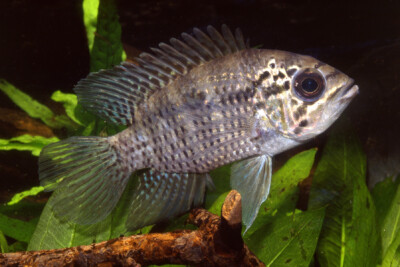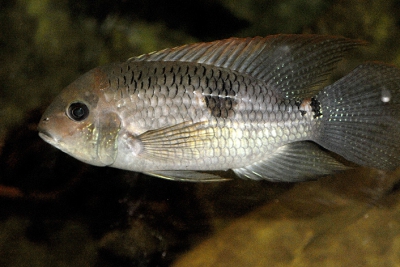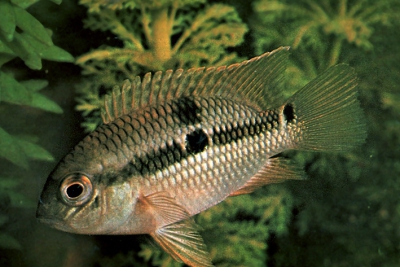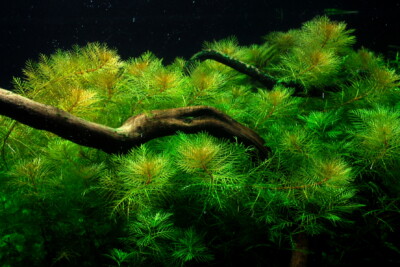Gymnogeophagus australis
| Scientific name | Gymnogeophagus australis |
|---|---|
| Descriptor | Eigenmann |
| Year of description | 1907 |
| IUCN category (World) | LC |
| Family | Cichlidae |
| Genus | Gymnogeophagus |


Introduction
Gymnogeophagus australis is a fresh water fish from the Amérique du Sud.
This sheet is currently being prepared. The texts currently proposed come from our data model or are being drafted. To request priority for this content, you can write to us HERE.
Who is it?
Morphology
-
Average size14 cm
-
Maximum size16 cm
-
Longevity10 year
-
Average size14 cm
-
Maximum size16 cm
-
Longevity10 year
How to recognize This fish ?
Gymnogeophagus australis measures around 14 cm. The dominant males can however reach 16 cm.
Sexual dimorphism
The adult male is bigger than the female.
Behaviour & Life cycle
-
dietomnivorous
-
Sociabilityliving as a couple or in a group
-
territorialYes
-
Way of livingdiurnal
This species tends to be easily stressed: this uneasiness is characterized by the appearance of marked black bars on its whole body.
Gymnogeophagus australis is a fish living as a couple or in a group naturally found near the bottom. This species is omnivorous . Naturally, it tends to dig into the sand and transform its environment.
Although slightly territorial, Gymnogeophagus australis is a rather peaceful animal that generally behaves in a peaceful manner with other species. It should be noted that it is sometimes less tolerant with its conspecifics. Parades or even small jousts may occur between different members of the group until a hierarchy is established.
Reproduction
-
Reproductionovipare qui pond sur substrat découvert
Gymnogeophagus australis is a fish ovipare qui pond sur substrat découvert.
Harmless species
This species does not represent any particular threats to humans when encountered in its natural environment.
Origin and distribution
Conservation status of populations (IUCN)
What is its habitat?
Natural environment characteristics
-
Temperature15 - 26 °C
-
pH (acidity)6.5 - 7.5
-
gh (hardness)5 - 15
-
FlowSlow and Stagnant
Biotope presentation
This animal evolves in areas characterized by a strong presence of vegetation (aquatic and marsh plants, decaying organic matter, roots...).
Species of the same biotope
Main recommendations for fishkeeping
Deontology
In order to preserve wildlife, if you acquire this animal, it must not be released into the wild. See also, the Fishipedia charter.
Fishipedia supports the practice of responsible and environmentally friendly aquarium keeping. We encourage maintenance if it is motivated by a desire to understand the biological functioning of living things and if it is done with respect for animal life.
We believe that aquaristics is an opening to the discovery of aquatic environments, especially freshwater, and that this knowledge is necessary to better protect and respect these environments. Logically, we refute the compulsive purchase of animals that would not find a sufficient and / or adapted place in the host aquarium.
Our recommendationsThese tips apply to adult species from breeding. With regards to water conditions, wild species or close relatives must be kept under the same conditions as in their area of origin.
-
Min volume400 liters
-
Population min5
-
Temperature15 - 26 °C
-
pH (acidity)6.5 - 7.5
CharacteristicsThe characteristics below apply for adult species. They correspond to an average of cases, validated in maintenance condition.
-
Difficulty breedingThe farming difficulty is relative. It depends on experiments already carried out with similar species. First, it takes into consideration the robustness of the species, the ease of recreation of a favorable environment and the general behaviour with the other inhabitants of the aquarium.easy
-
Robustnessrobust
-
Behaviourpeaceful
-
Availabilityoccasional
Recommended equipment from our partners
-
Aquarium
-
Filtration
Cohabitation & Environment
In a community aquarium context, this species should be kept in a minimum volume of 400 liters.
Fearful by nature, it is advised not to let Gymnogeophagus australis cohabit with large territorial species or with too aggressive fish. It can easily evolve with territorial neighbors with a peaceful temperament or with non-territorial species.
Be careful to plan an adequate space for each territorial species. Each species should have a surface and a decor allowing it to juxtapose its territory with that of its neighbors.
Gymnogeophagus australis is a fish that generally lives in groups outside of the reproduction periods. If you want to reproduce them and have a good chance of forming a couple, it is recommended to keep at least 5 individuals.. In a community aquarium, the chances of survival of the larvae are almost null. After a few spawns, it is preferable to isolate the couple or to separate from the other members of the group.
The hierarchical organization and the aggressiveness between fellow fish can weaken certain individuals, the presence of hiding places becomes then necessary. If you wish to add new members, it is better to introduce younger fish. They will have a better chance of integrating into the new balance.
The species enjoys a particularly vegetation-rich environment. The addition of plants will provide many useful hiding places for resting. These areas are also conducive to possible breeding in the aquarium.
Tips for feeding
Gymnogeophagus australis is omnivorous.
This species can eat dry food (flakes, pellets), fresh food and frozen food. To avoid deficiencies, it is recommended to vary the types of food.
You should not overfeed your residents to avoid polluting the water. For most species, it is better to feed a few small portions each day rather than one large meal.
Food recommendations from our partner JBL - Products PRONOVO
-
Granules
-
Flakes
Reproduction protocol
-
Maintenance difficultyeasy
-
egg-laying protectionYes
Reproduction of this species in an aquarium is considered easy. Ideally, it takes place at a temperature of around 24 ° C for a pH of 7 .
Hybridization risks
In general, it is advised not to mix several species of the same genus or different varieties of the same species, to avoid the risks of hybridization.
These animals might interest you
These plants might interest you
Plants play a crucial role in aquariums, both for their ability to filter water by absorbing excess nutrients and for their aesthetic contribution. They provide fish with natural hiding places, can serve as breeding sites, and generally help maintain the overall balance and optimal conditions of the aquarium. The selection presented here includes species from the same regions as the species described on this page, although they do not necessarily come from its exact natural biotope.
To go further
Sources & Contributions
Participation & Validation
The Fishipedia team and specialist contributors are committed to providing high-quality content. However, although the information comes from scientific sources or testimonials from specialists, the cards may contain inaccuracies.

Robert Allgayer
Translation
Translation done with the valuable contribution of our translators, who make this information available to a wider audience. We sincerely thank them for their commitment.
In collaboration with : Fédération Française Aquariophilie
Scientific partners
Species of the same family
Same genus
Species of the same biotope

































